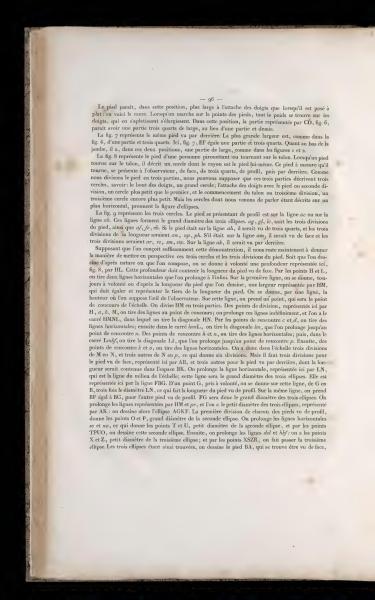The foot appears, in this position, wider at the base of the toes than when placed flat: here is why. When walking on tiptoes, all the weight is on the toes, which flatten and widen. In this position, the part represented by CD, fig. 6, appears to be three-quarters the width, instead of at the end.
Figure 7 shows the same foot from behind: The greatest width is, as in fig. 6, one and three-quarters parts. Here, fig. 7, EF equals one and three-quarters parts. Regarding the lower leg, it has, in these two positions, one part of width, as in figures 1 and 2.
Figure 8 depicts the foot of a person pivoting or turning on the heel. When a foot turns on the heel, it describes a circle whose radius is the foot itself. The foot, as it turns, is seen by the observer: front, three-quarters, profile, and then from behind. As we divide the foot into three parts, we can assume these three parts describe three circles: the tip of the toes, a large circle; the base of the toes with the foot in the second division, a smaller circle than the first; and the beginning of the heel or third division, an even smaller circle. But the circles we speak of, traced on a horizontal plane, take the shape of ellipses.
Figure 9 depicts the three circles. The foot viewed in profile is on the line ac or on the line ab. These lines form the large diameter of the three ellipses. ag, gl, lc, represent the three divisions of the foot, as do af,fe, ei. If the foot were on the line ah, it would be seen from three-quarters, and the three divisions of its length would be am, np, pb. If on the line ai, it would be seen from the front and the three divisions would be ar, ms, sc, etc. On the line ak, it would be visible from behind.
Assuming one sufficiently grasps this demonstration, it now remains to demonstrate how to put these three circles and the three divisions of the foot in perspective. This time, another view of the ellipse is presented, on a plane of composition, based on the depth indicated by fig. 8, represented by HL.
This depth should contain the foot length desired. From points H and L, two horizontal lines are drawn and extended indefinitely. Along the first line, based on the foot length one desires, is a width represented by a width equal to one-third of the foot length. A vertical line is assumed to be the scale for the observer: On this line, a point is measured out, which will be the point of convergence of the scale. HLM is divided into three parts. From these division points, represented here by H, a, b, M, lines are drawn to the point of convergence; these lines are prolonged indefinitely, and a square HMNL is drawn, along which the diagonal HN is traced. From the intesection points c and d, horizontal lines are drawn; then in the square LML, the diagonal LM is traced, which extends to the intersection point n. From intersection points k and h, horizontal lines are drawn; then in square LMF, the diagonal LC is traced, extending to an intersection point p. From intersection points z and o, horizontal lines are drawn. In this scale, there are three divisions from M to N, and three others from N to p, which gives six divisions. But three divisions are needed for the foot seen from the front, represented here by AB, and three others for the foot seen from behind, whose length would be contained within space BK.
The horizontal line is prolonged, represented here by LN, which is the middle line of the scale; this line is the large diameter of the three ellipses. It is represented here by line FBG. From an arbitrary point G, on this line, from G to B is measured three times the diameter LN, which creates the foot's profile length. On the same line, BF is taken equal to BG, for the other foot's profile. FG will thus be the large diameter of the three ellipses. The lines represented by HM and pr are prolonged, and the small diameter of the three ellipses, represented by AK, is drawn. The ellipse AGKFE is drawn accordingly. The first division of each foot viewed in profile gives the points O and P, the large diameter of the second ellipse. Horizontal lines sc and no extended give the points T and U, the small diameter of the second ellipse, wherewith points TPUO, the second ellipse is drawn. Next, the lines hl and hf are prolonged, revealing points X and Z, small diameter of the third ellipse; and with points X SZR, the third ellipse is formed. With the three ellipses found, the foot BA is drawn, which appears viewed from the front.
Translation Notes:
- 'Ellipses' refer to the geometrical shape used in perspectives to depict depth and rotation.
- 'Three-quarters' relative to 'fig. 6' illustrates how the foot is visually divided for better understanding of structure.
The text explains how the foot appears wider at the base of the toes when walking on tiptoes and details perspectives of a foot in different orientations, including from the front, side, and back. It discusses the geometrical representation of the foot through circles and ellipses and provides a method to draw these perspectives for a viewer. The document guides how to visualize and illustrate the various dimensions and positions of a foot in artistic representation.
